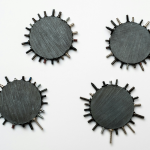Magnet Grades: An Exploration of Pull Force, Gauss, and N Numbers
Magnet grades serve as a sort of compass to navigate the intricate world of magnetic materials, guiding people through the nuances of strength and position. In this exploration, we start to unravel the mysteries surrounding pull force, gauss, and N numbers, as well as the often perplexing language of magnets.
What Are Magnet Grades?
Magnet grades, represented by N numbers like N42 or N52, offer insight into the strength of neodymium magnets. The N denotes the material type, with “N” standing for neodymium. The subsequent number signifies the strength, measured as the Maximum Energy Product or BHmax in MegaGauss Oersteds (MGOe). Appended letters, such as SH, convey temperature resistance.
Magnets defy easy quantification, often measured in ranges or averages. N ratings correlate with the grade of the neodymium (NdFeB) powder used, where higher rates indicate dense magnets and, consequently, greater strength. N48 boasts 13,800 - 14,100 gauss, while N40 ranges from 12,700 - 13,000 gauss.
Gauss and Pull Force: Clarifying the Confusion
Pull force, a key indicator of magnet strength, is not only influenced by the magnet’s properties but also its position — whether horizontal or vertical. Understanding this positional dependency is crucial for accurate assessments of a magnet’s strength in diverse applications.
Note: Gauss or Tesla are different from pull force. It’s essential to recognize that these units measure different aspects of magnetism. To dispel confusion, it’s crucial to emphasize that Gauss and Tesla are equivalent, just expressed differently.
Manufacturers provide both a Manufacturer’s Gauss and a Surface Gauss for magnets. This duality can be likened to measuring sound volume. Say a woman is singing opera in the center of a room and you are standing beside her with a decibel meter that measures a volume of 100 decibels. If she continues singing at that same volume and you walk outside the room and take another measurement, you may only get a reading of 25 decibels.
In this analogy, the volume in the center of the room is equivalent to the Manufacturer’s Rating, and the volume outside the room is equivalent to the Surface Gauss reading. The Surface Gauss will always be less than the Manufacturer’s Rating. And because no two magnets are quite the same, readings are taken on five magnets of the same shape, size, and N rating to get an average Surface Gauss rating.
Apex Magnets
Selecting the right magnet grade involves considering various factors, including cost, strength, and temperature resistance. Apex Magnet’s is knowledgeable on these ratings and happy to help you make the right choice. Should you ever want to talk about the nuances of magnetic grade or magnetic “language,” call our magnet specialists at 1-304-257-1193.

